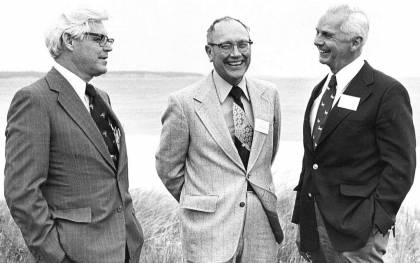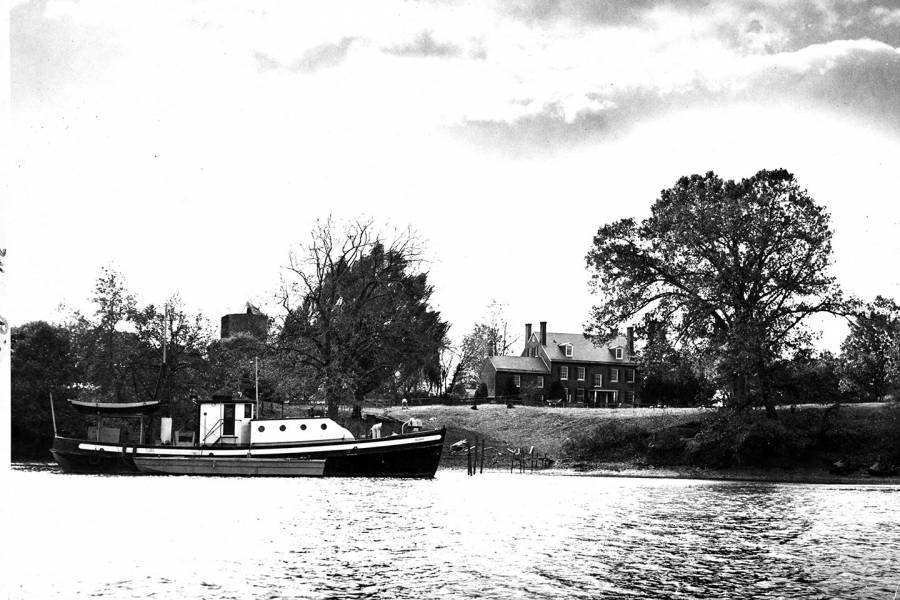No one seems to know for certain what became of the Ridgely Warfield. By some accounts, the 106-foot steel catamaran, once the crown jewel of a group of Chesapeake Bay scientists, ended up with a South American cartel after a spell with a private owner in Florida.
In its prime, the Warfield served as the floating laboratory for the Chesapeake Bay Institute, a Johns Hopkins research center that led the nation's studies of estuaries for the better part of four decades. Most scientists who passed through CBI spent time aboard the catamaran, which made its celebrated first launch from Annapolis in June 1967.

Image caption:Ridgely Warfield docked beside large crane
Image credit: Johns Hopkins University Sheridan Libraries Special Collection
As sophisticated a research vessel as it was, with a well-equipped lab and cruising range of 1,000 miles, the Warfield often made for a jostling, nauseous ride. "It was an incredibly powerful boat, but not particularly comfortable. Many oceanographers got seasick," recalls Bill Boicourt, who worked as a CBI research scientist in the 1970s and early '80s. Boicourt estimates he spent at least half a year's worth of his life on the Warfield, including one turbulent Thanksgiving eve anchored offshore, when the cook had to tie down the baked turkey to keep it from being flung overboard.
These expeditions in close quarters—some stretching for weeks and the entire 200 miles of the bay, down to the continental shelf of the Atlantic—may explain the familial feeling many still associate with the institute. "It was a small community of people who spent a lot of time on boats together," says Mike Mallonee, a longtime CBI technician.
In 1980, Washington Post reporter Eugene Meyer joined CBI for a summer voyage on the Warfield, which was then gathering data for a $27 million study of the Chesapeake Bay, set in motion by the Environmental Protection Agency. The work of the CBI researchers on ship was not glamorous—"it's not a National Geographic special or a Jacques Cousteau movie," one researcher quipped to the reporter—but a meticulous process of collecting water samples to measure saltiness, cloudiness, and nutrients in the bay.
Meyer experienced the Warfield's signature nausea one morning as a squall ambushed the vessel at the mouth of the Chesapeake, white-capped waves lashing its bow. Once the storm eased, a languid afternoon followed, with the Warfield docked in a Norfolk shipyard, dwarfed by giant freighters surrounding it. The ship's cook sunbathed on the front deck, as lyrics wafted from the radio: "Won't you let me take you on a sea cruise."
In one sense, the Chesapeake Bay Institute began with D-Day. That was the moment a young oceanographer named Donald Pritchard, then a weather officer for the U.S. Army Air Corps, made his mark as part of the team forecasting conditions for the amphibious landings off the shores of Normandy. (Famously, Gen. Eisenhower delayed the invasion by two days until this group of meteorologists and oceanographers gave him the all-clear on June 6, avoiding crushing waves that may have been catastrophic.)
Oceanography in general had gained esteem during World War II, as the Allies recognized the value of detailed coastal data for approaching the European and Pacific theaters. After the war, Roger Revelle, chief oceanographer of the U.S. Office of Naval Research, was among those who turned their attention to the Chesapeake Bay, envisioning a new research institute to enhance America's edge in ocean science—something of a mid-Atlantic equivalent to the Scripps Institution of Oceanography and the Woods Hole Oceanographic Institution. Partnering with Johns Hopkins University, he believed, would provide instant stature as well as proximity to the Naval Academy in Annapolis.

Image caption: Don Pritchard (center) with colleagues Bill Hargis and Gene Cronin at the Bi-State Conference on the Chesapeake Bay in 1977
Image credit: Chesapeake Research Consortium
With an initial budget of $90,000 and backing from the Navy and from Maryland and Virginia, the Chesapeake Bay Institute formally launched in 1948, setting out to investigate the physical, chemical, and biological properties of the bay—and, in turn, all estuaries, partially enclosed coastal bodies mixing saltwater and freshwater.
Surely Pritchard's D-Day performance was a reason his name came up in the search for CBI directors, along with his recent work at the Naval Electronics Laboratory. At just 27, fresh with his master's degree from Scripps, Pritchard considered the job offer a "rather romantic opportunity," he later wrote.
The Chesapeake Bay held a sort of primordial mystique for Pritchard, associated with the early Native American villages that cropped up around its waters and the explorations of Captain John Smith, the first to produce a near-accurate map of the bay in 1608. "Suddenly I had been given charge of one of the most interesting projects in that field—the largest body of water of its kind in the United States and one rich in the earliest history of our nation," he wrote in a Baltimore Sun editorial. In 1952, Pritchard was also named chair of the new graduate program in oceanography at Johns Hopkins, which became virtually synonymous with CBI. In its first 25 years, the program graduated 21 PhDs and 45 master's students, several of whom went on to lead top oceanography programs across the country, according to Johns Hopkins historian of science Bill Leslie.
Those who worked with Pritchard remember him as a brilliant, introverted, somewhat aloof figure, known for his exhausting work ethic and his experimental, inventive mind. "He'd throw you into the deep end of the pool," says Jerry Schubel, who worked as a CBI research scientist for about 14 years. "Just about the time you were going down for the third time, he'd throw you a lifeline and pull you back in."
Boicourt recalls that students would camp outside Pritchard's office for hours in order to meet with him, and "you'd enter trembling," he says, "but then he'd engage you for the most intellectually mind-bending two-hour discussion."
For those researchers who eventually advanced to become colleagues of Pritchard's, the gruffness would soften, the humor would sneak out, and lifelong friendship was secured. "He'd bring you in then—and he was very appreciative, and loyal, and proud, and encouraging," Boicourt says.
In its early days, CBI operated from a renovated mansion turned field station on Ridout Creek near Annapolis, with minimal office space on the Johns Hopkins Homewood campus. The institute initially leased a research vessel from Woods Hole but later built its own ship, the 65-foot Maury.

Image caption: Aboard the Maury on the bay, scientists look through seaweed samples.
Image credit: Johns Hopkins University Sheridan Libraries Special Collection
Wanting to increase CBI's visibility on the Hopkins campus, Pritchard raised $1.15 million—from the Navy, the National Science Foundation, and the Atomic Energy Commission—to build a new laboratory and teaching facility. Named after a longtime Johns Hopkins provost, Macaulay Hall debuted in 1964.
Pritchard was also the man behind the Ridgely Warfield, securing $1.6 million for the vessel from NSF and an avant-garde Navy architect to design it. Constructed by Bethlehem Steel in the shipyards of Baltimore, the twin-hulled catamaran would become a familiar sight clipping along the bay.
Under Pritchard, the Chesapeake Bay Institute cemented its reputation as an international leader in the study of estuaries. In large part, that reputation was linked to Pritchard's seminal discovery—through expeditions on the James River—of the bay's two-layered circulation pattern: lighter freshwater on top, flowing seaward above the denser, colder saltwater flowing upriver. His 1952 paper working out the mathematics of this system revolutionized thinking about the bay and estuaries around the world, and it remains an unchallenged reference point today.
"It's absolutely fundamental to our understanding of the estuarine system," Schubel says. "If you don't understand the physics—how the water moves, how it mixes, how long it takes to be exchanged and replaced—you can't deal with any of the pollution problems or the biology."
The Chesapeake Bay has always been a ponderous subject for research, given the geography and jurisdictions it spans. Running from the headwaters of the Susquehanna River in Havre de Grace, Maryland, down to the mouth of the Atlantic in Cape Henry, Virginia, the bay is not only the nation's largest estuary but also one of the world's largest. The bay's broader watershed covers more than 64,000 square miles, touching six states and the District of Columbia, by way of more than 100,000 rivers, streams, and creeks.
"You've got more than 18 million people living in that watershed, and every one of them impacts the bay," Schubel says.
The Chesapeake Bay Institute, in its time, explored many facets of this complex system. Scientists researched the survival and life patterns of blue crabs, oysters, rockfish, and other vital commercial species, and studied the ecology of plankton and algae. They explored how the winds, tides, and currents subtly and dramatically affected life and growth in the bay, fastidiously recorded its levels of salinity and oxygen, and traced how pollutants and industrial waste were moved through its waters.
CBI experts also frequently played consulting roles, according to Leslie. For the Navy, they took on a classified contract to study harbor defense. They advised on the siting of the Calvert Cliffs nuclear plant, and that of an oil refinery on the York River. CBI's research also helped plan the widening of the Chesapeake and Delaware Canal, allowing larger ships to pass through.
"The beauty of CBI is … we were studying basic oceanography but also seeing how it could be applied to real-world problems," says Stan Wilson, who earned his PhD in physical oceanography from Johns Hopkins and worked for CBI for nearly a decade.
In 1954, The Baltimore Sun ran a photo feature on "the Frogmen of the Chesapeake": CBI researchers donning rudimentary scuba gear to dive into the turbid December waters, observing oyster beds in their undisturbed state. Larry Harding, a CBI scientist who studied plankton ecology in the 1980s, conducted research from a higher vantage point: a De Havilland Beaver aircraft for remote sensing of the bay.
After Tropical Storm Agnes dumped historic rainfall and sediment into the bay's watershed in 1972—a galvanizing event for research and restoration efforts for the estuary—CBI studied its impacts for the EPA. Ultimately, researchers say, CBI's data would support the Chesapeake Bay Program, the first formalized effort to address the bay's declining health, born in 1983 by act of Congress.
Never a massive operation, CBI was known to have an impact that was disproportionate to its size. "People who know CBI's research ask me how big it was," Boicourt says. "And really it was a small group of people. It started when oceanography was a new field. But it was led by a brilliant man, who hired great people, and we achieved real breakthroughs that are still referenced today."
CBI's identity suffered a blow in 1968, when the Department of Oceanography at Johns Hopkins was absorbed into the new Department of Earth and Planetary Sciences. Owen Phillips, chair of the new department, was an oceanographer himself but by most accounts not particularly compelled by the work of CBI. In a letter to then university President Steven Muller, Phillips described the institute as "parochial, inflexible, and essentially parasitic to the Department," and "run very much as a family operation, by Dr. Pritchard." Of the Warfield, he wrote: "Although it's fun to ride about in a Hopkins boat, it doesn't make good sense in the long run for the University to tie itself to the large and expensive vessel."
Later Pritchard, who was never skilled at navigating university politics, would consider the merger a "hostile takeover," according to Leslie. Battling cancer in 1973, Pritchard resigned from CBI, leaving Schubel, his former PhD student, to take over temporarily as director. But Schubel departed shortly afterward to head SUNY's Marine Sciences Research Center at Stony Brook—eventually bringing a healthier Pritchard with him along with several CBI researchers, including Japanese oceanographer Akira Okubo, who later became internationally recognized.
Without Pritchard, CBI lost its footing at Hopkins. "He left no heir apparent. There was nobody there left to fight the fight in the higher circles at Hopkins," says Stan Wilson, who added: "Once the name 'Oceanography' disappeared, there was no great attraction for oceanographers."
The new department structure symbolized a shift away from the kind of local applied research that was CBI's specialty. "Hopkins chose to think globally, even cosmically, and to leave traditional fieldwork and local action to other divisions and institutions," Bill Leslie writes in a forthcoming book on the history of Johns Hopkins University. The university would "continue to attract world-class oceanographers, but they would consider themselves theorists and modelers, not field scientists, and certainly did not privilege the study of the Chesapeake Bay."
On its face, the grand opening of a new CBI facility in Shady Side, Maryland, in 1981, looked like reinvigorated support for the institute. Donated to Johns Hopkins by the Gould Corporation, the compound on the West River promised a "front-row seat" to the action of the bay, The Sun wrote in a glowing account of the institute's prospects.
With a $1 million upgrade to the facility, and a few scientists from the Applied Physics Laboratory's aquatic ecology program joining, vital research on the bay continued through the 1980s, including major studies for the EPA and Bill Boicourt's initial work on the Chesapeake Bay Observing System, setting up monitoring stations for constant data collection along the estuary. Another young researcher at the time was Jody Deming, whose work on extremophiles—microorganisms living in extreme environments—later earned her membership to the National Academy of Sciences.
Behind the curtains, though, CBI was ailing. When "Skip" W.R. Taylor accepted directorship in 1981, he acknowledged the institute's "substantial problems in funding and building a staff."
Among CBI scientists, there was a sense of Johns Hopkins detaching. "It's difficult to have a lab 50-something miles from the main campus," says institute alum Larry Harding. Isabel Miles, the administrative manager of CBI for about a decade, says hardly anyone at Hopkins would nod in recognition when hearing the institute's name. "No one knew it was there," she says. "No one knew there was a research fleet, or what they did."
Nonetheless, many CBI alumni from that generation carry nostalgia for the days they shared at Shady Side as a close-knit, independent group. On the grounds during their off-time, they'd play cribbage or volleyball, and gather for crab dinners.
"They were really good times, and there was almost a family-like feeling," says Mike Mallonee, who started work as a CBI technician when he was just 19 and was known as the "young'un" among a staff of mostly middle-aged men.
The staff also remembers the Valentine's Day when they were gathered for the announcement that CBI was shutting down, the casualty of Hopkins budget cuts. Bruce Marsh, who chaired the Department of Earth and Planetary Sciences around this time—when the university was "in crisis mode" with finances, he says—recalls difficult discussions over the closure. "It was one of these appendages we simply couldn't afford anymore," he says.
Environmentalists working to restore the bay considered the decision a hurtful blow. "I think it's a serious loss," the vice president of the Chesapeake Bay Foundation told The Washington Post at the time. "They have distinguished themselves in the field. It's really a shame, especially now that we are clearly recognizing a need for research on these issues."
Today, Macaulay Hall—freshly renovated in 2018—houses labs and classrooms for departments unrelated to oceanography, and CBI's former Shady Side facility is listed for sale as vacant office space along the river. Evidence of the institute's impact as a major player in oceanography is preserved now among its top scientific papers, the archives at Johns Hopkins, and the memories and ongoing work of its alumni, some of whom continue to meet up for reunions. Many from Pritchard's time attended his funeral in 1999, mourning the loss of a friend.
Some lamentations do remain on the "could have beens" with the Hopkins center, which closed officially and quietly in 1991. "We have all these many thousands and thousands of bricks of knowledge involved in the Chesapeake Bay, but do we assemble them into a meaningful picture?" Schubel asks. "That could have been a wonderful role for Hopkins to play—using the power of the Hopkins brand to bring together people from across disciplines, not just within the Chesapeake Bay region but from across the country."
Other respected research centers carry on the work of the CBI, including the Virginia Institute of Marine Science at William & Mary and the Horn Point Laboratory at University of Maryland's Center for Environmental Science—where a number of CBI researchers ultimately landed, along with the Ridgely Warfield for a time. But "what is not being done as well as it could," according to Schubel, "is to integrate that research, fuse the resulting knowledge, and ask what it means for all these issues that we face with the bay, and how we can shape its future."
Schubel, who later was CEO of the New England Aquarium and the Aquarium of the Pacific, recently published a book that addresses these concerns, The Future Chesapeake (Archway Publishing, 2021). He's one of several CBI alumni who have remained connected to the bay. Larry Harding and Eric Itsweire—later director of physical oceanography at the National Science Foundation—worked with NASA scientists to develop a long-term program using aircraft and satellite instruments to monitor climatic effects on the estuary's phytoplankton. Mike Mallonee now manages water quality data for the Chesapeake Bay Program.
Boicourt, an expert in the circulation of estuaries who recently retired from UMD's Horn Point Laboratory, was interviewed for this story while sitting on his porch overlooking the Choptank River, a Chesapeake Bay tributary. While he spoke, he spotted a great blue heron in the distance. "A lot of strong feelings still surround CBI," he says. "It's a mark of how much we achieved but also the spirit of this group of people."












